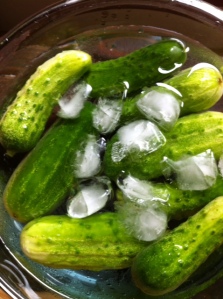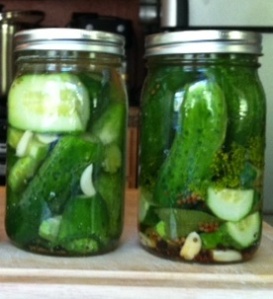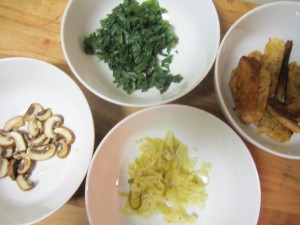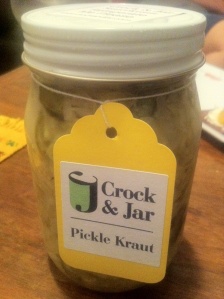I love pickles.
I love gherkins and dills and bread-and-butter chips. I love dilly beans and vinegary blueberries. I love pickled okra and beet-stained turnip pickles and pretty much any kind of pickle you can think of.
But I am hands-down crazy about half-sours.
Half sour pickles (and their puckery cousin the full-sour) are to me what a pickle should be – crispy and salty and refreshing. None of this limp, neon-green nonsense that you see in the salad aisle.
The thing that makes half-sours so crispy and delicious is that they are fermented, not cooked or heat-processed. Surprisingly, the worldwideweb is a little thin on half-sour recipes, so I thought I’d share mine here.
Half-Sour Pickles
Yield: 2 1-quart jars of pickly goodness
Protip 1: use the freshest possible pickle cukes. I try to pick and pickle in the same day.
Protip 2: Pickle cucumbers are not just smaller salad cucumbers. They’re a different kind of cuke, generally full grown at six inches or so, and paler green, sometimes with light-colored stripes lengthwise down the skin – not dark green like a salad cuke. They’ve got a thicker skin and crisper flesh then other cucumbers.
Ingredients:
- 10 -12 pickling cucumbers, very fresh with the stem trimmed off
- 1/2 tsp. whole coriander seeds
- 1 tsp. pepper corns
- 1/2 tsp. mustard seed
- 1/2 tsp. crushed pepper flakes
- ¼ tsp. dill seeds
- 2 dried bay leaves
- 4 mature dill blossoms
- 4 cloves fresh garlic
- ¼ cup pickling salt (don’t mess with this and use sea salt or table salt. You need pickle salt.)
- 5 cups purified water
Instructions:
1. Soak your cucumbers in a bowl of icy water for about 15 minutes while you prepare the pickling spice.
 2. Dissolve the salt in the water.
2. Dissolve the salt in the water.
3. Put all your dry spices into a plastic bag and hit them with a hammer. (I tried grinding them with a pestle and they got too ground up, but a few whacks with a hammer – or firm rolls with a rolling pin – cracks your mustard seeds open and busts up your pepper flakes without pulverizing anything.
 4. Split the garlic cloves, pickle spices, and dill blossoms evenly between your jars.
4. Split the garlic cloves, pickle spices, and dill blossoms evenly between your jars.
5. Cram pickles into the jars. I usually chop up a few into half-sizes and throw them in the bottom, and then line the perimeter of the jar with pickles sliced in half lengthwise (skin facing in), and then shove a few whole cukes into the center of each jar. Try to keep your pickles tucked underneath the shoulders of the jar.
6. Pour your brine into each jar, making sure that all your pickles are fully submerged.
7. Put your pickle jars in a pan (in case the fermentation makes them spill over a bit) and put the lids on loosely.
8. Store your pickles in a cool dark place for a few days. Start tasting them at the end of each day – mine were ready to go in 48 hours. The longer they sit, the more they sour – so for half-sours, a few days should be fine, and for full sours, it may take up to a week. Things that may happen and are normal include: the water gets cloudy, they fizz and foam, the garlic turns turquoise (although using fresh garlic will prevent this last one).
9. When they’ve fermented to where you want them, tighten the lids and refrigerate. You can keep them for months – they will keep fermenting, but very very slowly once in the fridge.
DELICIOUS!





